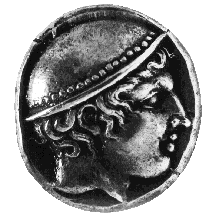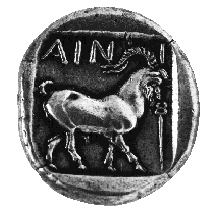



(26) Ainos, Thrace (Turkey) - AR tetradrachm, c. 412-410 B.C.,
16.44 g. (inv. 91.044).
Obverse: Head of Hermes wearing petasos r.
Reverse: In incuse, goat r.; kerykeion in r. field;
![]() : abbreviation for "of the Ainians."
: abbreviation for "of the Ainians."
Provenance: Edward Gans, 1960.
Bibliography: J.M.F. May, Ainos, its history and coinage
(Oxford 1950).
Ainos was a Greek colony on the northeastern coast of the Aegean. Its location
on the mouth of the river Hebros made it an important shipping center for
agricultural exports from the interior of Thrace. Though not the first in
eastern Thrace, its mint dominated regional coinage soon after its first
issues c. 475 B.C. From the beginning its die-cutters rejected the usual
animal types used by most mints of the area and instead used a series of
beautiful heads of the chief god of Ainos, Hermes, as its obverse type.
Hermes, the messenger god and patron of merchants and herdsmen, was probably
worshipped at Ainos from early times. According to legend, a wooden statue
of the god washed ashore at the mouth of the Hebros, where local fishermen
caught it in their nets. They failed to recognize it and threw it back into
the sea, only to catch it again. The statue was finally set up in a sanctuary,
and an oracle of Apollo told Ainos to worship it along with the local gods.
An armless and legless image on the reverse of some coins of Ainos is probably
meant to represent the primitive statue. As the god of the marketplace and
commerce, Hermes is also appropriate to Ainos. On this coin he wears his
characteristic petasos or broad-rimmed hat.
The reverse depicts a goat, reference to Hermes' role as the divine herdsman.
In front of it is a kerykeion, Hermes' heraldic staff, one of a number
of symbols on the reverses which changed with each issue.
P.A.M.



All contents copyright (c) 1996.
Lawrence University
All rights reserved.